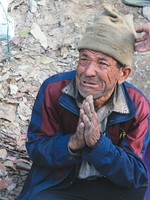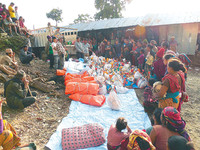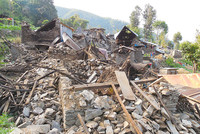Cloudy, 26° F
“I ran down the metal stairway as it was rattling back and forth and into the house,” Panday recalled. “The earthquake alarm was ringing, and Nikita looks at me and goes, ‘Earthquake!’ and keeps watching her movie. Yep, just another day in …
This item is available in full to subscribers.
The Powell Tribune has expanded its online content. To continue reading, you will need to either log in to your subscriber account, or purchase a subscription.
If you are a current print subscriber, you can set up a free web account by clicking here.
If you already have a web account, but need to reset it, you can do so by clicking here.
If you would like to purchase a subscription click here.
Please log in to continue |
|




A day after Nepal was devastated by a major earthquake, Northwest College alumna Laurel Panday was hanging laundry on her roof when a powerful aftershock hit. She rushed into her home, where her 3-year-old daughter Nikita was watching a movie.
“I ran down the metal stairway as it was rattling back and forth and into the house,” Panday recalled. “The earthquake alarm was ringing, and Nikita looks at me and goes, ‘Earthquake!’ and keeps watching her movie. Yep, just another day in Nepal ...”
Panday, originally from Pinedale, now lives in Pokhara, Nepal, with her husband, Paulas, and their two children.
“It’s very strange being in the middle of a national disaster like this, where the entire world’s eyes are on you, where nearly every person who knows your name is calling or writing to see if you’re OK,” Panday said in an email. “It’s very surreal.”
A new magnitude-7.3 earthquake killed dozens of people today (Tuesday) and spread more fear and misery in Nepal, as the country is still struggling to recover from a devastating quake nearly three weeks ago that left more than 8,000 dead, according to The Associated Press.
Panday has lived in Nepal for five years, and she describes the Nepali people as strong, hard-working and self-sufficient.
“But they have been struck with fear and staggering loss in this tragedy,” Panday said. “They will pick back up and rebuild and carry on with their lives, but it may take a long time, and for many of them, life will never be the same. Many have lost family members; many have been displaced because their village areas are no longer safe to live in.”
Panday felt the ground shake underneath her for nearly two minutes during the April 25 earthquake, but she said her city of Pokhara was “strangely sheltered” from significant damage.
“We were just as far from the epicenter as Kathmandu, but we saw almost no damage here,” Panday said. “We can wake up in the morning, and it seems like any other average day, but we know that not even 50 miles from us, people are in immense suffering.”
It has been difficult for aid workers to reach villages hit hardest by the earthquake. An estimated 8,000 people died in the earthquake according to The Associated Press, and many were injured and lost their homes.
Relief work challenges
Every hillside in Nepal is dotted with villages, and many of them are a multiple days walk from the nearest road, Panday said.
“It was right in the middle of this setting that the earthquake hit,” she said. “Villages are decimated, flattened to the ground, sometimes with less than 10 percent of houses left standing. They lost their food, shelters, and water supplies were contaminated.”
Some villages still have not received aid, two weeks since the earthquake.
“Helicopters have been delivering aid and ferrying the injured down to the cities, but they still have not scratched the surface of the need,” Panday said.
People are trying to take supplies to remote villages by foot.
“But it’s like trying to deliver aid for tens of thousands of people from Pinedale to Lander via the Wind River Mountains,” Panday said.
In the days since the earthquake, Panday has heard reports from friends who have returned from their home villages in Nepal.
“They reported that some people were able to dig through the rubble of their homes and salvage their dry food supplies, which they store up for a year at a time,” she said. “But they have no way to keep it dry, and some areas have been getting hammered with rain.”
A continuing concern for Panday is how relief efforts will be sustained over time.
“In so many areas, trucks full of food are being taken up, but they can only fit enough for a few days. How do you sustain this kind of thing?” she said. “There’s no way people can keep taking truck loads of food to all these villages every few days. It’s just overwhelming.”
Still, even in desperate situations, stories of hope have emerged, Panday said.
“There have been several reports of people being dug out of the rubble alive days, and even more than a week, after the earthquake, including a 4-month-old baby that was rescued after being buried for 22 hours,” she said.
Panday said it’s amazing to see how people are helping those in need.
“People from all across Nepal are drawing together and going out into the villages to bring relief to their families and friends,” she said. “Churches in Pokhara are filled with relief supplies to be taken to the villages.”
Helping those in need
For Americans who want to donate financially, Panday recommended the organization Extreme Response International. (See related infobox below.)
“They have been involved in numerous projects in Nepal before. All donations are tax deductible,” she said.
For those who pray, Panday requested prayers for the social and political situation in Nepal, as well as healing.
“Pray for their emotional healing, for healing from fear, and that they will feel God’s love reaching out to them even in the midst of this tragedy,” she said.
The Nepali are living on edge because of the aftershocks, and they fear another major earthquake.
“Many people slept outside in tents or under tarps because they were afraid to go back inside their homes,” she said. “But as for us — we all slept in one room for several days after the earthquake, but otherwise, we’re pretty calm and not worried. It’s no use to be tense and just wear yourself out even more!”
Panday and her family recently moved into a new home and had an earthquake alarm installed.
“It’s not common. We just got ours a month before the earthquake from an international organization here that was selling them,” she said. “But there are very few people who actually have one — really, just a handful of foreigners and maybe some schools or offices and such.”
Earthquakes always have been a reality of life in Nepal.
“According to the pattern throughout history, Nepal was several years overdue for another major earthquake,” Panday said. “Everyone knew it would come someday, and everyone wondered when that would be.”
NWC alumna Laurel Panday, formerly of Pinedale and now living in Nepal, recommends giving donations through Extreme Response International, an organization that has been involved in numerous projects in Nepal.
Donations can be made online at www.extremeresponse.org/take-action/make-a-donation
Be sure to designate donation as “Earthquake relief fund — Pokhara, Nepal.”
Donations will go toward relief work in surrounding villages affected by the April 25 earthquake.